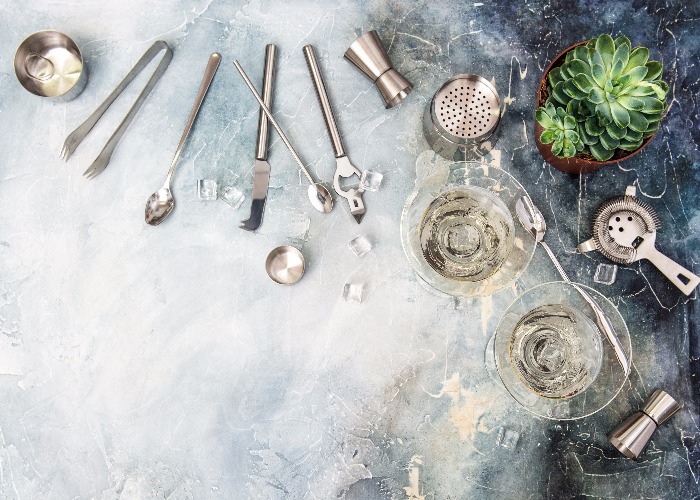How to make the perfect martini

The cocktail everyone should know how to make at home.
This classic cocktail tastes just as great – and looks just as cool – today as it did in the Mad Men era. Winston Churchill and James Bond were big fans, and now it’s your turn to tackle what top American bartender Dale DeGroff calls “the king of cocktails”.
The basic recipe
Let’s cut to the chase: despite its legendary status, a martini is one of the easiest cocktails to make at home. All you need is plenty of gin (or vodka if you want to annoy the purists – more of which later) plus a little dry vermouth. That’s the body of the drink sorted.
You’ll also need a twist of lemon rind, green olives or cocktail onions to garnish, depending on what floats your boat.
1. Add one part dry vermouth to four parts gin in a glass packed full of ice.
2. Stir for thirty seconds (keeping the stirrer away from the glass to keep everything extra cold) before straining into a chilled martini glass.
3. Add your choice of garnish to finish – and that’s your lot. Or at least it would be if there weren’t a million controversies and complications around this famous drink.
 Pixabay
Pixabay
Cocktail controversies
Cocktail connoisseurs argue that gin is the only choice for a martini. Why? Collar one at the bar and they’ll tell you that gin has a unique depth of flavour that neutral-tasting vodka just can’t touch. They’re right – but don’t let that put you off if you fancy the crisp-tasting hit that only the Russian stuff can provide.
If you really want to infuriate the aficionados, you could try making an appletini (with vodka and green apple liqueur) or even a ‘porn star’ martini (served with a shot of Prosecco on the side).
Here, we’ll stick with the classics.
 Pixabay
Pixabay
To stir or not to stir
In the world of martinis, James Bond has a lot to answer for. Ever since Ian Fleming had his famous secret agent demand a shaken-not-stirred martini, many people have chosen to follow his lead.
But here’s the thing: using a cocktail shaker causes ice to disintegrate straight into the gin, leading to a watery pour. This is called ‘bruising’ the gin.
So, for a stronger, better drink, ignore 007 and order it gently stirred instead.
 Pixabay
Pixabay
The importance of keeping things chilled
A martini is basically a glass of ice-cold gin, which gives the spirit’s unique botanical flavours a chance to cut through. That’s great news, since gin is having a bit of a ‘moment’ as small-batch producers come up with ever-more inventive takes on the traditional English spirit.
Whatever bottle you choose, ensure that the martini is served cold. After all, a glass of room-temperature gin is as unappetising as it sounds.
Top tippler and comic writer Kingsley Amis recommended sticking martini glasses in the fridge for a couple of hours before using, to keep drinks cooler for longer. He also nailed the reason why it’s better to serve small martinis since “the second half of a too-large martini will have become too warm by the time the average drinker gets to it”. Wise words.
Make it yours
Half the fun of making a martini is the personalisation. For a simple drink there’s a lot to consider, from its strength to the choice of garnish.
One of the most important decisions is the ratio of gin to vermouth – which determines exactly how ‘dry it is’ (drier drinks are more spirit-heavy).
Gin-fancier Winston Churchill, when asked how dry he’d like his drink, apparently answered that he “would like to observe the vermouth from across the room while I drink my martini.” Unlike Winston, you might prefer to pace yourself with a version that uses more vermouth, and is a little bit less drunk-inducing.
 Pixabay
Pixabay
Lovers of ultra-umami flavours might like to try putting a couple of drops of brine from the olive jar into the finished product to make a dirty martini. Also on the pickle spectrum is the Gibson martini, which is served with a couple of cocktail onions.
Whatever you choose, don’t make the mistake of using too-big olives (or fat cocktail onions). They can override the complexity of the spirit and crowd out the liquid in your glass.
That’s why lemon rind is still the most popular finishing touch. To take things up a level rub it around the rim of the glass to release the skin's natural oils, adding a zesty, refreshing aroma. Cheers!
You might also like:
Comments
Do you want to comment on this article? You need to be signed in for this feature